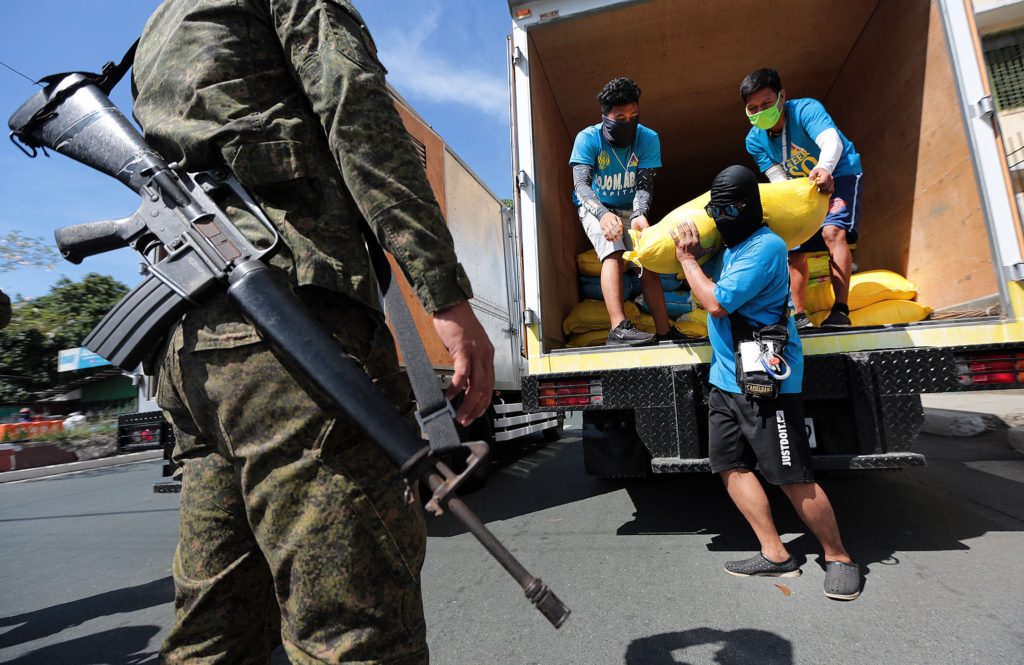
ADB ASSISTANCE The Philippine Army provides security on Tuesday to a relief operation by the Asian Development Bank for Quezon City residents under quarantine due to the coronavirus pandemic. —GRIG C. MONTEGRANDE
MANILA, Philippines — President Rodrigo Duterte may relax quarantine restrictions in low to moderate-risk parts of the Philippines in a phased reopening of the economy while the country tries to beat back the onslaught of the new coronavirus.
In a televised address to the nation late on Monday, Mr. Duterte said some sectors of the economy, such as construction, might be allowed to open “partially” but under strict public health regulations to prevent the spread of SARS-CoV-2, the new coronavirus that causes the severe respiratory disease COVID-19.
More than 860 Filipinos have been killed since the local outbreak in February.
“It’s imminent. Others will still be in lockdown while we may open partially—construction workers and things like that. You just wait for the modified quarantine,” Mr. Duterte said.
A bit of normality
He said some sectors of society might be allowed a bit of normality, though they would be required to strictly observe social distancing.
“We cannot be cramped together. It has to be modified. If you will just cram into the LRT (Light Rail Transit) again, there will be no end to our problem,” he said.
Mr. Duterte announced the plan three days after he extended the Luzon lockdown to May 15 in Metro Manila and other parts of the country with numerous coronavirus infections but relaxed quarantine restrictions in parts of the country with few cases of the disease starting May 1.
Public transportation and selected businesses in specific industries will be allowed partial resumption of operations in parts of the country where quarantine restrictions will be loosened.
Earlier, Malacañang said the Inter-Agency Task Force on Emerging Infectious Diseases, the temporary government body overseeing the administration’s response to the coronavirus pandemic, was completing guidelines to be implemented in parts of the country under the “general community quarantine” (GCQ) imposed on Metro Manila and other parts of the country with high infection rates.
GCQ is the government’s term for limited restrictions in areas with low to moderate rates of infections; the opposite is “enhanced community quarantine” (ECQ) or lockdown.
High-risk areas
In his press briefing on Tuesday, presidential spokesperson Harry Roque said Metro Manila, Central Luzon (except for Aurora), Calabarzon, Pangasinan, Benguet, Baguio City, Iloilo, Cebu, Cebu City and Davao City made up the updated list of high-risk areas.
Capiz, Aklan, Davao del Norte and Davao de Oro were removed from the list, he said.
Oriental Mindoro, Occidental Mindoro, Albay, Catanduanes, Antique and Davao del Norte were on the list released by Roque’s office on Friday, but they were no longer on the new list.
A statement released by Roque’s office on Friday said Antique, Iloilo, Aklan, Capiz, Cebu, Cebu City, Davao del Norte, Davao City and Davao de Oro would be placed on the list, subject to the assessment of the task force.
A check of Roque’s PowerPoint presentation on Friday showed that Capiz, Aklan and Davao de Oro were “moderate risk” areas.
As of press time on Tuesday night, the Palace had yet to respond to requests for clarification on just how many provinces were removed from the list of high-risk areas.
In his briefing, Roque said there would be a decision by May 15 if some places on the high-risk list would be moved to low to moderate-risk list, inspiring hope among Metro Manilans of gaining access to personal services, such as barbershops.
Roque read through the lists of services that would be allowed to open partially under “modified quarantine” (see list), including dental clinics but not barbershops even though barbers who only cut hair are less in danger of contracting the coronavirus than dentists who work through the open mouths of people who may be infected.
Schools will remain closed in low and moderate-risk areas, Roque said.
Employees’ protection
In his speech on Monday night, Mr. Duterte thanked the public for obeying the lockdown regulations.
“I thank you for heeding the warnings of [the] government to observe the quarantine to protect [yourselves],” he said, referring to the coronavirus crisis as “war.”
He also reminded shop owners and shopping mall operators to make sure their establishments were clean and their employees protected once they reopened for partial operations.
Last week, Mr. Duterte approved the task force’s recommendation to allow nonleisure shops in shopping malls in low to moderate-risk areas to reopen partially.
“When you asked us to open, we agreed. But there are the protocols to be followed,” he said.
The rules include temperature check, wearing protective masks, use of sanitizers and controlled entry of people.
Establishments that will be allowed to reopen partially are supermarkets, drugstores, banks, laundry shops, restaurants for takeout and delivery, and hardware stores.
Businesses will be required to provide their employees with gloves and protective masks. Shopping malls will be directed to maintain air-conditioning temperature at 26 degrees Celsius and disconnect free Wi-Fi to discourage people from lingering in the premises.
5th report to Congress
In his fifth weekly report to Congress on the coronavirus crisis, Mr. Duterte said government planners had submitted to the task force recommendations for response, mitigation and transition to what they called “new normal.”
He said the response phase would focus on strengthening the health-care system by increasing testing capacity, contact tracing, erecting quarantines, and adding hospital beds and medical equipment to curb transmission of the virus.
The mitigation phase includes the provision of strategies to ensure food security and reduce financial losses.
Also in the exit plan is the preparation of an economic risk assessment and possible resumption of operations for high-value sectors with low risk of spreading the coronavirus, the President said. INQ
For more news about the novel coronavirus click here.
What you need to know about Coronavirus.
For more information on COVID-19, call the DOH Hotline: (02) 86517800 local 1149/1150.